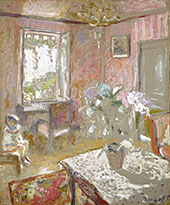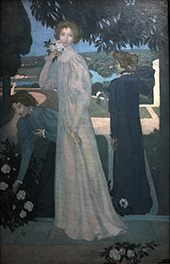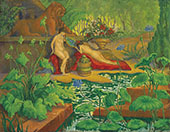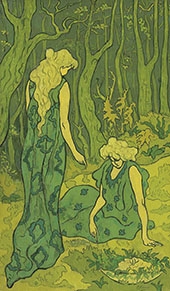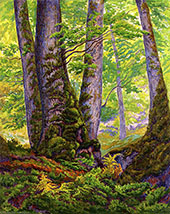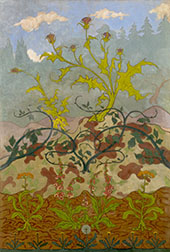Les Nabis Oil Painting Reproductions
Find Les Nabis oil painting replicas by Les Nabis artists
Les Nabis: A Brief Introduction
Les Nabis were a group of Post-Impressionist painters working in France during the late 19th century. Their colorful modern art usually features flat and vivid primary hues, simplified compositions, and bold painterly brushstrokes. Lasting from 1888 to 1900, it was a relatively short-lived artistic movement. Nonetheless, Les Nabis painters transformed modern French art.
So, who were these pioneering artists? This brief introduction explores the critical figures of this art movement and their most exciting famous oil paintings.
What is Le Nabis in Art History?
Many artists met while studying at the Academie Julian in Paris, France. This art school offered a less rigid approach to teaching than the highly traditional Ecole des Beaux-Arts. The group came together in the autumn of 1888, led by Paul Serusier. They formed in secret, feeling even the more liberal teaching of the Academie Julian was still too strict. Les Nabis artists wished to move away from rigid representational art. Instead, they adored Paul Gauguin’s synthetism, focusing on symbolism, flat colors, and bold forms.
This art style combined traditional subject matter with the individual artist’s emotions and thoughts. Les Nabis artists also synthesized these abstract concerns with a more conventional painterly line, form, and color issues. Speaking of their approach, the painter Maurice Denis commented that any image, be it a “nude woman” or “battle horse,” was “a flat surface covered with colors.” For Denis, it was an artist’s job to assemble and represent these colors in a particular order.
What does Les Nabis mean in English?
The term “Les Nabis” comes from the Hebrew word (Navi), meaning “prophet” or “seer.” The French physician and Symbolist poet Henri Cazalis came up with the description. He used it to show how this group of painters revitalized painting, presenting them as “prophets” of Modern Art. Cazalis argued that Les Nabis artists rejuvenated France’s art scene like ancient prophets invigorated religion in Israel.
Who were the Les Nabis artists?
Led by Paul Serusier, Les Nabis artists included Maurice Denis, Pierre Bonnard, and Edouard Vuillard. Felix Vallotton and Paul Ranson were also members. In addition, painters such as Ker-Xavier Roussel and Auguste Cazalis aren’t as well known today but played a fundamental role in the group’s early output.
Together, these artists had an unconventional approach to creating modern art. They experimented with painting on surfaces other than just canvases. Indeed, some famous paintings appeared on cardboard and even velvet. They also experimented with theater and set design, graphic arts, murals, wallpaper, dishware, and more.
What are the Nabis artists known for painting?
Art Historians cite Les Nabis' paintings as a critical transition between Impressionist and Post-Impressionist art and modern developments. These later movements included Symbolism, Abstract Art, and early Modernism.
While all Les Nabis artists admired painters such as Paul Cezanne and Paul Gauguin, their styles differed significantly. For instance, artists like Edouard Vuillard produced artworks covered in dappled color and quick brushstrokes. Woman in Striped Dress 1895 and Woman Arranging Her Hair 1900 are just two examples of Vuillard’s unique style.
In contrast, artists like Pierre Bonnard favored broader, flatter planes of vibrant color. Bonnard’s quick and expressive style (inspired by Japanese printmaking) appears in oil paintings such as Woman with Dog 1891.
What was the purpose of Paul Serusier paintings?
Paul Serusier paintings served as a foundational inspiration for Les Nabis artists. In his oil paintings, Serusier tried to free both form and color from their traditional roles. Like his mentor Paul Gauguin, Serusier wanted to express personal emotions and spiritual truths in his art.
The Talisman, or Paysage au Bois d’Amour 1888, demonstrates Serusier’s approach to art. Painted under the guidance of Gauguin at an artist’s colony in Brittany, other Les Nabis artists called it “the talisman.” This nickname stemmed from the painting’s iconic place in the group and was regarded as an emblem of the movement.
Indeed, Paul Serusier’s fellow artists saw this colorful painting as a starting point for Les Nabis' philosophy. The artwork emotionally represents the natural world with its bright colors and flattened perspective. For Serusier, color was now a vehicle for communicating emotions rather than depicting figurative elements. Serusier’s approach also inspired later art movements such as Abstract Expressionism.
Was Bonnard part of Les Nabis?
Pierre Bonnard paintings are a prime example of Les Nabis art. Indeed, fellow painters referred to Pierre Bonnard as “Le Nabi tres Japonard''. Translating as the “very Japanese Nabi,” this nickname referenced Bonnard’s fascination with Japanese painting techniques.
Pierre Bonnard and other Les Nabis artists focused on domestic interior scenes and sweeping landscapes. Bonnard created several interior scene paintings where his figures almost disappeared into the richly detailed background. This approach is evident in Bonnard’s paintings of his wife, Marthe de Meligny which often portray her washing and drying herself or lying in the bath.
One of these paintings, Nude in the Bath 1936, best demonstrates Bonnard’s approach to flattened perspective and opulent detailing. The woman’s bath almost melts into the wall behind. Similarly, the golden light in the background flows into her hair and the floor below.
When did the Les Nabis movement end?
The Les Nabis artists held their final group exhibition at the Galerie Bernheim in Paris 1900. Before this date, the group organized shows at the Galerie Vollard. After 1900, each artist continued their creative endeavors. While no longer exhibiting as a formal group, most Nabis artists continued to create colorful artworks with synthesized symbols and natural forms.
Speaking of the Group’s importance, Maurice Denis commented how their art was no longer a “visual sensation” of nature. Instead, he described Les Nabis' paintings as a “creation of our spirit.” Other avant-garde art movements, such as Surrealism and Cubism, rapidly took precedence after this date.
Les Nabis: Colorful Modern Art Oil Paintings
Buy colorful wall art of Les Nabis oil painting reproductions. Explore our extensive collection of replica art to discover iconic Paul Serusier paintings, the work of Pierre Bonnard, Edouard Vuillard, and many Popular Artists.
High quality replica art will bring joy and color to your home or office walls.
Cannot Find What You Are Looking For?
Reproduction Gallery Information
Customer Service
(Send Us A Message)
Tel: (503) 937 2010
Fax: (503) 937 2011












